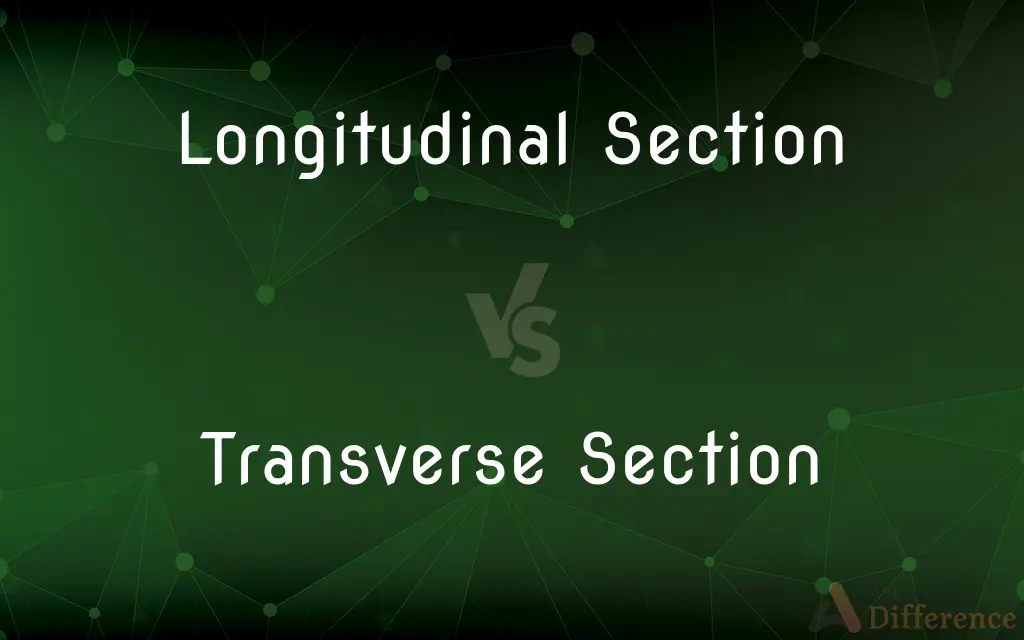Longitudinal Section vs. Transverse Section — What's the Difference?
By Tayyaba Rehman — Published on November 27, 2023
Longitudinal Section involves a cut along the longest axis of an object, revealing a view from end to end, whereas Transverse Section pertains to a cut perpendicular to the long axis, providing a cross-sectional view.

Difference Between Longitudinal Section and Transverse Section
Table of Contents
ADVERTISEMENT
Key Differences
Longitudinal Section often provides a comprehensive view of the entire length of an object or organism, displaying details that run consistently along its full extent. On the contrary, a Transverse Section grants an explicit look into the interior of an entity, allowing for an intimate exploration of its internal structures and composition at a specific point. While the Longitudinal Section reveals the progressive, sequential arrangement of internal structures, the Transverse Section uncovers the juxtaposition and spatial relationships of internal aspects at a singular level.
Longitudinal Section is invaluable in observing the development or progression of certain features or phenomena along the entire length of a specimen. In contrast, a Transverse Section is crucial when needing to study the detailed, intricate internal aspects of a specimen at a specific locale. The longitudinal approach provides an overarching perspective, encapsulating the developmental or structural continuum of an entity, whereas the transverse approach delves into the detailed anatomy, often revealing structural diversity and density within a singular plane.
In botanical studies, a Longitudinal Section of a plant could showcase the flow and arrangement of vascular bundles from root to tip, providing insights into nutrient transport pathways. Contrarily, a Transverse Section of a stem, for example, could unveil the arrangement and density of these vascular bundles at a particular node, lending insights into nutrient distribution and structural support at that precise point. While viewing a Longitudinal Section might reveal elongated structures like vessels and fibers, observing a Transverse Section could expose the radial arrangement of tissues and their proportional occupancy within the stem.
Longitudinal Section in studies involving animal specimens might elucidate the linear arrangement and connection of organ systems or skeletal structures throughout the body. Alternatively, Transverse Section can offer a look into the width, symmetry, and organization of organs, tissues, or skeletal elements at a certain body segment. The holistic linearity of systems could be interpreted through Longitudinal Section, whereas Transverse Section would decode the axial interplay and proportional distribution of structures within a given level.
In research and diagnostics, Longitudinal Section might be employed to study the progression of a disease or condition along an entire organ or tissue. Conversely, a Transverse Section might be crucial in understanding the impact, invasion, or severity of a condition at a specific stage or point within an organ or tissue. By inspecting through Longitudinal Section, the path and progression of a condition might be analyzed, whereas by examining a Transverse Section, the depth and density of a condition’s manifestation could be assessed at a particular stage or location.
ADVERTISEMENT
Comparison Chart
Direction of Cut
Along the longest axis of the object.
Perpendicular to the longest axis.
View Provided
Entire length of the object.
Cross-sectional view at a specific point
Application in Studies
Observing progression of features.
Studying specific internal structures.
Structural Revelation
Elongated, continuous structures.
Spatial and proportional relationships.
Used in Analyzing
Development or progression of phenomena.
Detailed anatomy at a particular level.
Compare with Definitions
Longitudinal Section
Longitudinal Section helps understand the linear connection of systems.
A Longitudinal Section of the snake revealed the linear arrangement of vertebrae.
Transverse Section
A Transverse Section offers a cross-sectional view of a specimen.
The Transverse Section of the log revealed its internal ring structure.
Longitudinal Section
A Longitudinal Section displays a specimen’s entire length.
The Longitudinal Section of the stem illustrated the flow of vascular bundles.
Transverse Section
Transverse Section can expose proportional occupancy of structures.
Analyzing a Transverse Section of the kidney showed various internal structures.
Longitudinal Section
Longitudinal Section aids in analyzing progression or development of phenomena.
Observing the tumor's Longitudinal Section revealed its growth direction.
Transverse Section
Transverse Section is pivotal in examining specific internal structural details.
The Transverse Section of the heart displayed chamber walls and valve structures.
Longitudinal Section
Longitudinal Section cuts are parallel to the longest axis.
The Longitudinal Section of the carrot showed the root's entire span.
Transverse Section
Transverse Section helps in inspecting structural density at specific points.
The Transverse Section of the bone showed its density and porosity at that segment.
Longitudinal Section
A Longitudinal Section can illustrate sequential arrangement of structures.
A Longitudinal Section of the spinal cord depicted nerve pathway progression.
Transverse Section
Transverse Section involves cutting perpendicular to the longest axis.
A Transverse Section was made through the thigh to study muscle arrangement.
Common Curiosities
What can a Longitudinal Section of a plant stem show?
It can show the arrangement and flow of vascular bundles from root to tip.
How is a Transverse Section cut made?
A Transverse Section is made by cutting perpendicular to the object's longest axis.
What view does a Longitudinal Section provide?
Longitudinal Section provides a view along the entire length of a specimen.
When is a Transverse Section typically utilized?
A Transverse Section is utilized to study specific internal structures at a certain level of a specimen.
How can a Transverse Section assist in research studies?
Transverse Section can help in understanding the internal structures and their organization at a specific segment.
Why might one choose to analyze a Longitudinal Section?
Analyzing a Longitudinal Section can reveal the sequential arrangement and progression of structures.
Can a Longitudinal Section be utilized in medical diagnostics?
Yes, a Longitudinal Section can be used to observe the progression of a condition along an organ.
What information might a Transverse Section of an organ provide?
It might provide detailed insights into the spatial relationships of internal structures at a specific point.
Are Longitudinal Sections always vertical?
No, Longitudinal Sections are oriented along the longest axis, which might not always be vertical.
What is one purpose of studying a Transverse Section in anatomy?
Studying a Transverse Section can reveal the spatial and proportional relationships of internal structures.
How do Longitudinal Sections assist in analyzing plant structures?
Longitudinal Sections can reveal the continuous arrangement of vascular structures and pathways in plants.
Does a Transverse Section always produce a circular view?
No, the shape of a Transverse Section depends on the shape of the object being cut.
What scientific fields often utilize Longitudinal Sections?
Fields like botany, zoology, and medical research often utilize Longitudinal Sections.
Share Your Discovery

Previous Comparison
Share Capital vs. Share Premium
Next Comparison
Atomic Mass Unit vs. Atomic MassAuthor Spotlight
Written by
Tayyaba RehmanTayyaba Rehman is a distinguished writer, currently serving as a primary contributor to askdifference.com. As a researcher in semantics and etymology, Tayyaba's passion for the complexity of languages and their distinctions has found a perfect home on the platform. Tayyaba delves into the intricacies of language, distinguishing between commonly confused words and phrases, thereby providing clarity for readers worldwide.
















































